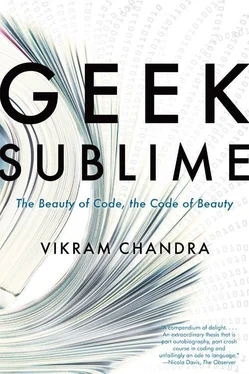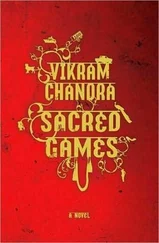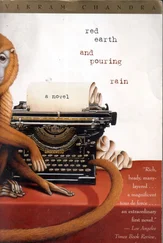68. Varma, “Computing Self-Efficacy among Women in India,” 257.
69. Varma, “Exposure, Training, and Environment,” 213.
70. Ibid., 215.
71. Ibid., 217.
72. Ibid., 219.
73. Ibid.
74. Alok Aggarwal (co-founder and chairman, Evalueserve), e-mail to author, December 8, 2012.
75. Alok Aggarwal (co-founder and chairman, Evalueserve), e-mail to author, February 15, 2013.
76. Varma, “Exposure, Training, and Environment,” 219.
77. Fine, Delusions of Gender , 94.
78. Ibid., 181–82.
79. Sivakumar, Dude, Did I Steal Your Job? , 34.
80. Ibid., 140–46.
81. Ibid., 144.
82. Ibid., 141.
83. Wadhwa, “The Face of Success, Part I: How the Indians Conquered Silicon Valley.”
84. See, for instance: Raj, “Indian Mafia”; Warner, “The Indians of Silicon Valley.”
85. Lanier, “The Suburb That Changed the World.”
Chapter 5: The Code of Beauty: Anandavardhana
1. Ramanujan, The Interior Landscape , 74.
2. Ibid., 115.
3. Harpham, “Aesthetics and the Fundamentals of Modernity,” 124–25.
4. See Leeming, The Oxford Companion to World Mythology.
5. Kiparsky, “Paninian Linguistics,” 1.
6. “Astadhyayi has two distinct bodies of sutras — the 14 Maheswara or pratyahara sutras of Sanskrit varnas, sounds, that are the primary building blocks of the Sanskrit language, that are enumerated before the sutrapatha begins. The sutrapatha, according to the now ascertained authentic text (ed. by Pt. Narayana Mishra and published by Chowkhamba Varanasi) has 3976 sutras. Sometimes the 14 pratyahara sutras are conjoined to make the total 3990.” Kapil Kapoor, e-mail to author, September 9, 2013.
7. Kiparsky, “Paninian Linguistics,” 5.
8. See Matthews, The Concise Oxford Dictionary of Linguistics , 284.
9. Kiparsky, “Paninian Linguistics,” 6.
10. Ibid., 7.
11. Panini, Ashtadhyayi , 47.
12. Kapoor, Text and Interpretation: The Indian Tradition , 74.
13. Joshi, “Background of the Aṣṭādhyāyī,” 2.
14. Ganeri and Miri, “Sanskrit Philosophical Commentary,” 193.
15. See Manjali, “The ‘Social’ and the ‘Cognitive’ in Language: A Reading of Saussure, and Beyond.”
16. Emeneau, “Bloomfield and Pānini,” 759.
17. Ibid., 758–59.
18. Bloomfield, Linguistic Aspects of Science , 2.
19. Kiparsky, “Paninian Linguistics.”
20. Kiparsky, “On the Architecture of Pāṇini’s Grammar.”
21. Emeneau, “India and Linguistics,” 150.
22. Ingerman, “Panini-Backus Form Suggested,” 37.
23. Kelly, “What Was Sanskrit For? Metadiscursive Strategies in Ancient India,” 103–04.
24. Pollock, The Language of the Gods in the World of Men , 50.
25. Houben, “Sociolinguistic Attitudes Reflected in the Work of Bhartṛhari and Some Later Grammarians,” 169.
26. Muller-Ortega, The Triadic Heart of Śiva , 133.
27. Pollock, The Language of the Gods in the World of Men , 53.
28. Ibid., 54.
29. Ibid., 55–56.
30. Briggs, “Knowledge Representation in Sanskrit and Artificial Intelligence,” 34.
31. Ibid., 36.
32. Ibid., 35–36.
33. Ibid., 39.
34. See Bhate and Kak, “Panini’s Grammar and Computer Science”; Staal, “Context-Sensitive Rules in Pāṇini”; Subbanna and Varakhedi, “Computational Structure of the Aṣṭādhyāyī and Conflict Resolution Techniques”; Saxena, Parul Saxena, and Pandey, “Panini’s Grammar in Computer Science.”
35. See “Similarities between Sanskrit and Programming Languages”; “Why Sanskrit Is Best Language for Computer?”
36. Jha and Mammaṭācārya, The Kāvyapṛakāsha of Mammaṭa , 148–49.
37. Ingalls Sr, Masson, and Patwardhan, The Dhvanyaloka of Anandavardhana with the Locana of Abhinavagupta , 131.
38. Ibid., 130.
39. Ibid., 122.
40. Ibid., 113.
41. Translated from Anandavardhana’s Dhvanyaloka (1.4 b) by Luther Obrock.
42. Translated from Anandavardhana’s Dhvanyaloka (1.4 c) by Luther Obrock.
43. Translated from Anandavardhana’s Dhvanyaloka (2.27 a) by Luther Obrock.
44. Bharata Muni and Rangacharya, The Nāṭyaśāstra , 55.
45. Translated from Anandavardhana’s Dhvanyaloka (2.22 b) by Luther Obrock.
46. Ingalls Sr., Masson, and Patwardhan, The Dhvanyaloka of Anandavardhana with the Locana of Abhinavagupta , 312.
47. Translated from Anandavardhana’s Dhvanyaloka (2.1 a) by Luther Obrock.
48. Ingalls Sr., Masson, and Patwardhan, The Dhvanyaloka of Anandavardhana with the Locana of Abhinavagupta , 204.
49. Ibid., 206.
50. Ibid., 105.
51. Hogan, “Towards a Cognitive Science of Poetics: Anandavardhana, Abhinavagupta, and the Theory of Literature,” 164.
52. Ingalls Sr., Masson, and Patwardhan, The Dhvanyaloka of Anandavardhana with the Locana of Abhinavagupta , 546.
53. Ibid., 679.
54. Ibid., 714–15.
55. Ibid., 636.
56. Ibid.
57. Ibid., 641–42.
58. O’Connor, Mystery and Manners , 96.
Chapter 6: The Beauty of Code
1. Matsumoto, “Treating Code as an Essay,” 478.
2. Ibid., 481.
3. Ibid., 477.
4. Purushothaman and Perry, “Toward Understanding the Rhetoric of Small Source Code Changes,” 513; McPherson, Proffitt, and Hale-Evans, “Estimating the Total Development Cost of a Linux Distribution.”
5. Knuth, “All Questions Answered,” 320.
6. Foote and Yoder, “Big Ball of Mud,” 653.
7. Paltrow and Carr, “How the Pentagon’s Payroll Quagmire Traps America’s Soldiers.”
8. Ensmenger, The Computer Boys Take Over , 227.
9. “The International Obfuscated C Code Contest.”
10. Ibid.
11. Scheffer, “Programming in Malbolge.”
12. Hayes, “Computing Science: The Semicolon Wars,” 299.
13. Dijkstra, “How Do We Tell Truths That Might Hurt?” 14.
14. “How SQLite Is Tested.”
15. “Most Widely Deployed SQL Database Engine.”
16. Savoia, “Beautiful Tests,” loc. 3010.
17. Bloch, “Extra, Extra — Read All About It: Nearly All Binary Searches and Mergesorts Are Broken.”
18. Grimes, “In His Own Words.”
19. Yegge, “Foreword,” XVII–XVIII.
20. “Hype Cycle Research Methodology.”
21. “GitFaq — Git SCM Wiki.”
22. Wolfcore [pseud.], comment on “Git Is Simpler Than You Think.”
23. “Whatever Happened to Programming?”
24. Campbell, “Where Does One Go to Find the Current ‘Good’ Books to Read? (Or Blogs?)”
25. Ensmenger, The Computer Boys Take Over , 88.
26. Kwak, “The Importance of Excel.”
27. Ibid.
28. Ibid.; Schlesinger, “JPMorgan Chase Earnings: ‘London Whale’ Cost $5.8 Billion.”
29. Oliver, “Why I Still Love CQRS (and Messaging and Event Sourcing).”
30. Ibid.
31. Zihotki, “Raven & Event sourcing.”
32. Chakrabarti, “Arguing from Synthesis to the Self: Utpaldeva and Abhinavagupta Respond to Buddhist No-Selfism,” 203.
33. Ibid., 209.
34. Ibid., 211.
Chapter 7: The Code of Beauty: Abhinavagupta
1. Gnoli and Abhinavagupta, The Aesthetic Experience According to Abhinavagupta , 55.
2. Ibid., 54–55.
3. Ibid., 64.
4. Ibid., 64–65.
5. Ibid., 66.
6. Ibid., 113.
7. Ibid., 61.
8. Ibid., 81.
9. Ibid., XXXVI.
10. Ibid., 117.
Читать дальше












